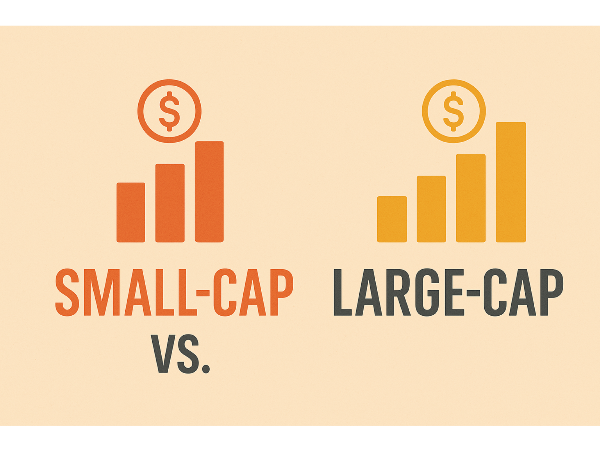Introduction
Stock classifications help investors assess risk and potential returns by categorizing companies based on their market capitalization. Small-cap stocks, typically valued between $300 million and $2 billion, represent early-stage companies with high growth potential but greater volatility. In contrast, large-cap stocks, valued at over $10 billion, belong to well-established firms with financial stability and lower risk. This article examines the risk levels associated with both categories, comparing their volatility, performance trends, and investment strategies. By understanding these differences, investors can make informed decisions that align with their financial goals and risk tolerance.
Understanding Small-Cap and Large-Cap Stocks
Market capitalization is a key metric used to classify companies based on their total market value. It is calculated by multiplying the current share price by the number of outstanding shares. Small-cap stocks typically have a market capitalization ranging from $250 million to $2 billion, while large-cap stocks exceed $10 billion. These classifications help investors assess risk levels, growth potential, and financial stability when making investment decisions.
Small-cap stocks are often associated with emerging companies that have high growth potential but also greater volatility. These firms may have limited financial resources, making them more susceptible to market fluctuations and economic downturns. However, they can offer significant upside for investors willing to take on higher risk. Small-cap stocks tend to be less liquid, meaning they may experience larger price swings due to lower trading volume.
Large-cap stocks, on the other hand, belong to well-established companies with strong financial stability and market dominance. These firms often generate substantial revenue, maintain steady profitability, and distribute dividends to shareholders. Large-cap stocks are generally less volatile than their small-cap counterparts, making them a preferred choice for conservative investors seeking long-term stability. Their ability to withstand economic downturns and maintain consistent earnings reinforces their appeal in diversified portfolios.
Risk Factors Associated with Small-Cap Stocks
Small-cap stocks are known for their higher volatility and price fluctuations compared to larger companies. Their smaller market capitalization makes them more susceptible to rapid changes in investor sentiment, leading to significant price swings. Historically, small-cap stocks have exhibited greater sensitivity to market trends, often experiencing sharp declines during economic downturns and rapid gains during periods of growth. While this volatility can present opportunities for high returns, it also increases the risk for investors who may struggle with unpredictable price movements.
Limited financial resources and funding challenges further contribute to the risk associated with small-cap stocks. These companies often have restricted access to capital markets and may rely heavily on debt financing, which can be costly. Unlike large-cap firms with established creditworthiness, small-cap companies may face difficulties securing favorable loan terms or attracting institutional investors. This financial constraint can hinder their ability to expand operations, invest in research and development, or navigate economic downturns effectively.
Market sensitivity and liquidity concerns also pose challenges for small-cap stocks. These companies are more vulnerable to economic downturns, as they often lack the financial cushion to withstand prolonged periods of instability. Additionally, lower trading volume can lead to liquidity issues, making it harder for investors to buy or sell shares without significantly impacting the stock price. This reduced liquidity can result in wider bid-ask spreads, increasing transaction costs and making small-cap stocks less attractive to risk-averse investors. Despite these risks, some investors seek small-cap stocks for their growth potential, balancing the inherent volatility with strategic portfolio diversification.
Risk Factors Associated with Large-Cap Stocks
Small-cap stocks are known for their higher volatility and price fluctuations compared to larger companies. Their smaller market capitalization makes them more susceptible to rapid changes in investor sentiment, leading to significant price swings. Historically, small-cap stocks have exhibited greater sensitivity to market trends, often experiencing sharp declines during economic downturns and rapid gains during periods of growth. While this volatility can present opportunities for high returns, it also increases the risk for investors who may struggle with unpredictable price movements.
Limited financial resources and funding challenges further contribute to the risk associated with small-cap stocks. These companies often have restricted access to capital markets and may rely heavily on debt financing, which can be costly. Unlike large-cap firms with established creditworthiness, small-cap companies may face difficulties securing favorable loan terms or attracting institutional investors. This financial constraint can hinder their ability to expand operations, invest in research and development, or navigate economic downturns effectively.
Market sensitivity and liquidity concerns also pose challenges for small-cap stocks. These companies are more vulnerable to economic downturns, as they often lack the financial cushion to withstand prolonged periods of instability. Additionally, lower trading volume can lead to liquidity issues, making it harder for investors to buy or sell shares without significantly impacting the stock price. This reduced liquidity can result in wider bid-ask spreads, increasing transaction costs and making small-cap stocks less attractive to risk-averse investors. Despite these risks, some investors seek small-cap stocks for their growth potential, balancing the inherent volatility with strategic portfolio diversification.
Performance Trends: Small-Cap vs. Large-Cap Stocks
Small-cap stocks have historically demonstrated higher growth potential but also greater volatility compared to large-cap stocks. Over the long term, small-cap stocks have often outperformed large-cap stocks, particularly during periods of economic expansion. According to historical data, small-cap stocks have delivered an average annual return of 17.4%, with notable peaks such as 67.1% in 2003 and 42.8% in 2021. However, they have also experienced sharp declines, including a -55.4% drop in 1931 and -36.6% in 2008. This volatility makes small-cap stocks attractive for investors seeking high returns but also presents significant risks.
Large-cap stocks, on the other hand, have shown more stability and consistent returns over time. The S&P 500, which tracks large-cap stocks, has historically provided an annualized return of 9.3% including dividends since the 1870s. While large-cap stocks tend to be less volatile, they still experience fluctuations based on macroeconomic conditions. For example, large-cap stocks saw a 21.5% gain in 2024, driven by strong performances from tech giants like Nvidia and Amazon. However, during economic downturns, large-cap stocks can also decline, as seen in the -25.12% drop in 1930 and -43.84% in 1931.
Investment cycles play a crucial role in determining the relative performance of small-cap and large-cap stocks. Historically, small-cap stocks have outperformed large-cap stocks during periods of high inflation, such as the 1970s. Additionally, market cycles tend to favor small-cap stocks after prolonged periods of underperformance, as seen in the current cycle, which has lasted 12 years—longer than the historical average of nine years. Understanding these trends helps investors make informed decisions about portfolio allocation and risk management.
Investment Strategies Based on Risk Tolerance
Portfolio diversification is a key strategy for managing risk when investing in small-cap and large-cap stocks. A well-balanced portfolio typically includes a mix of both categories, allowing investors to benefit from the growth potential of small-cap stocks while maintaining stability with large-cap holdings. Diversification across sectors and industries further reduces exposure to market fluctuations. Investors often allocate a percentage of their portfolio to small-cap stocks for higher returns while relying on large-cap stocks for consistent performance and dividend income.
Balancing growth potential with stability requires understanding market cycles and economic conditions. Small-cap stocks tend to outperform during periods of economic expansion, while large-cap stocks provide resilience during downturns. Investors seeking aggressive growth may allocate a larger portion to small-cap stocks, whereas those prioritizing stability may favor large-cap investments. Historical trends indicate that small-cap stocks have delivered higher returns over long periods, but they also carry greater volatility. Large-cap stocks, on the other hand, offer steady appreciation and lower risk, making them suitable for conservative investors.
Determining when to invest in small-cap versus large-cap stocks depends on market conditions and individual risk tolerance. Small-cap stocks are ideal for investors willing to accept short-term volatility in exchange for long-term growth. Large-cap stocks are preferable during uncertain economic periods when stability is a priority. Risk management techniques, such as dollar-cost averaging and sector diversification, help mitigate exposure to market fluctuations. Investors can also use stop-loss orders and hedging strategies to protect their portfolios from sudden downturns.
Conclusion: Which Is Riskier?
Investing in small-cap and large-cap stocks requires a careful assessment of risk tolerance and market conditions. Small-cap stocks offer high growth potential but come with increased volatility, funding challenges, and sensitivity to economic downturns. In contrast, large-cap stocks provide stability, steady dividends, and resilience during market fluctuations, though they may experience slower growth.
Historical performance trends indicate that both categories have advantages depending on investment cycles and broader economic shifts. By diversifying portfolios and employing strategic risk management techniques, investors can balance growth opportunities with financial security, making informed decisions that align with their long-term investment goals.




























Introduction
Stock classifications help investors assess risk and potential returns by categorizing companies based on their market capitalization. Small-cap stocks, typically valued between $300 million and $2 billion, represent early-stage companies with high growth potential but greater volatility. In contrast, large-cap stocks, valued at over $10 billion, belong to well-established firms with financial stability and lower risk. This article examines the risk levels associated with both categories, comparing their volatility, performance trends, and investment strategies. By understanding these differences, investors can make informed decisions that align with their financial goals and risk tolerance.
Understanding Small-Cap and Large-Cap Stocks
Market capitalization is a key metric used to classify companies based on their total market value. It is calculated by multiplying the current share price by the number of outstanding shares. Small-cap stocks typically have a market capitalization ranging from $250 million to $2 billion, while large-cap stocks exceed $10 billion. These classifications help investors assess risk levels, growth potential, and financial stability when making investment decisions.
Small-cap stocks are often associated with emerging companies that have high growth potential but also greater volatility. These firms may have limited financial resources, making them more susceptible to market fluctuations and economic downturns. However, they can offer significant upside for investors willing to take on higher risk. Small-cap stocks tend to be less liquid, meaning they may experience larger price swings due to lower trading volume.
Large-cap stocks, on the other hand, belong to well-established companies with strong financial stability and market dominance. These firms often generate substantial revenue, maintain steady profitability, and distribute dividends to shareholders. Large-cap stocks are generally less volatile than their small-cap counterparts, making them a preferred choice for conservative investors seeking long-term stability. Their ability to withstand economic downturns and maintain consistent earnings reinforces their appeal in diversified portfolios.
Risk Factors Associated with Small-Cap Stocks
Small-cap stocks are known for their higher volatility and price fluctuations compared to larger companies. Their smaller market capitalization makes them more susceptible to rapid changes in investor sentiment, leading to significant price swings. Historically, small-cap stocks have exhibited greater sensitivity to market trends, often experiencing sharp declines during economic downturns and rapid gains during periods of growth. While this volatility can present opportunities for high returns, it also increases the risk for investors who may struggle with unpredictable price movements.
Limited financial resources and funding challenges further contribute to the risk associated with small-cap stocks. These companies often have restricted access to capital markets and may rely heavily on debt financing, which can be costly. Unlike large-cap firms with established creditworthiness, small-cap companies may face difficulties securing favorable loan terms or attracting institutional investors. This financial constraint can hinder their ability to expand operations, invest in research and development, or navigate economic downturns effectively.
Market sensitivity and liquidity concerns also pose challenges for small-cap stocks. These companies are more vulnerable to economic downturns, as they often lack the financial cushion to withstand prolonged periods of instability. Additionally, lower trading volume can lead to liquidity issues, making it harder for investors to buy or sell shares without significantly impacting the stock price. This reduced liquidity can result in wider bid-ask spreads, increasing transaction costs and making small-cap stocks less attractive to risk-averse investors. Despite these risks, some investors seek small-cap stocks for their growth potential, balancing the inherent volatility with strategic portfolio diversification.
Risk Factors Associated with Large-Cap Stocks
Small-cap stocks are known for their higher volatility and price fluctuations compared to larger companies. Their smaller market capitalization makes them more susceptible to rapid changes in investor sentiment, leading to significant price swings. Historically, small-cap stocks have exhibited greater sensitivity to market trends, often experiencing sharp declines during economic downturns and rapid gains during periods of growth. While this volatility can present opportunities for high returns, it also increases the risk for investors who may struggle with unpredictable price movements.
Limited financial resources and funding challenges further contribute to the risk associated with small-cap stocks. These companies often have restricted access to capital markets and may rely heavily on debt financing, which can be costly. Unlike large-cap firms with established creditworthiness, small-cap companies may face difficulties securing favorable loan terms or attracting institutional investors. This financial constraint can hinder their ability to expand operations, invest in research and development, or navigate economic downturns effectively.
Market sensitivity and liquidity concerns also pose challenges for small-cap stocks. These companies are more vulnerable to economic downturns, as they often lack the financial cushion to withstand prolonged periods of instability. Additionally, lower trading volume can lead to liquidity issues, making it harder for investors to buy or sell shares without significantly impacting the stock price. This reduced liquidity can result in wider bid-ask spreads, increasing transaction costs and making small-cap stocks less attractive to risk-averse investors. Despite these risks, some investors seek small-cap stocks for their growth potential, balancing the inherent volatility with strategic portfolio diversification.
Performance Trends: Small-Cap vs. Large-Cap Stocks
Small-cap stocks have historically demonstrated higher growth potential but also greater volatility compared to large-cap stocks. Over the long term, small-cap stocks have often outperformed large-cap stocks, particularly during periods of economic expansion. According to historical data, small-cap stocks have delivered an average annual return of 17.4%, with notable peaks such as 67.1% in 2003 and 42.8% in 2021. However, they have also experienced sharp declines, including a -55.4% drop in 1931 and -36.6% in 2008. This volatility makes small-cap stocks attractive for investors seeking high returns but also presents significant risks.
Large-cap stocks, on the other hand, have shown more stability and consistent returns over time. The S&P 500, which tracks large-cap stocks, has historically provided an annualized return of 9.3% including dividends since the 1870s. While large-cap stocks tend to be less volatile, they still experience fluctuations based on macroeconomic conditions. For example, large-cap stocks saw a 21.5% gain in 2024, driven by strong performances from tech giants like Nvidia and Amazon. However, during economic downturns, large-cap stocks can also decline, as seen in the -25.12% drop in 1930 and -43.84% in 1931.
Investment cycles play a crucial role in determining the relative performance of small-cap and large-cap stocks. Historically, small-cap stocks have outperformed large-cap stocks during periods of high inflation, such as the 1970s. Additionally, market cycles tend to favor small-cap stocks after prolonged periods of underperformance, as seen in the current cycle, which has lasted 12 years—longer than the historical average of nine years. Understanding these trends helps investors make informed decisions about portfolio allocation and risk management.
Investment Strategies Based on Risk Tolerance
Portfolio diversification is a key strategy for managing risk when investing in small-cap and large-cap stocks. A well-balanced portfolio typically includes a mix of both categories, allowing investors to benefit from the growth potential of small-cap stocks while maintaining stability with large-cap holdings. Diversification across sectors and industries further reduces exposure to market fluctuations. Investors often allocate a percentage of their portfolio to small-cap stocks for higher returns while relying on large-cap stocks for consistent performance and dividend income.
Balancing growth potential with stability requires understanding market cycles and economic conditions. Small-cap stocks tend to outperform during periods of economic expansion, while large-cap stocks provide resilience during downturns. Investors seeking aggressive growth may allocate a larger portion to small-cap stocks, whereas those prioritizing stability may favor large-cap investments. Historical trends indicate that small-cap stocks have delivered higher returns over long periods, but they also carry greater volatility. Large-cap stocks, on the other hand, offer steady appreciation and lower risk, making them suitable for conservative investors.
Determining when to invest in small-cap versus large-cap stocks depends on market conditions and individual risk tolerance. Small-cap stocks are ideal for investors willing to accept short-term volatility in exchange for long-term growth. Large-cap stocks are preferable during uncertain economic periods when stability is a priority. Risk management techniques, such as dollar-cost averaging and sector diversification, help mitigate exposure to market fluctuations. Investors can also use stop-loss orders and hedging strategies to protect their portfolios from sudden downturns.
Conclusion: Which Is Riskier?
Investing in small-cap and large-cap stocks requires a careful assessment of risk tolerance and market conditions. Small-cap stocks offer high growth potential but come with increased volatility, funding challenges, and sensitivity to economic downturns. In contrast, large-cap stocks provide stability, steady dividends, and resilience during market fluctuations, though they may experience slower growth.
Historical performance trends indicate that both categories have advantages depending on investment cycles and broader economic shifts. By diversifying portfolios and employing strategic risk management techniques, investors can balance growth opportunities with financial security, making informed decisions that align with their long-term investment goals.